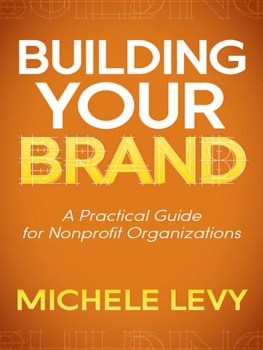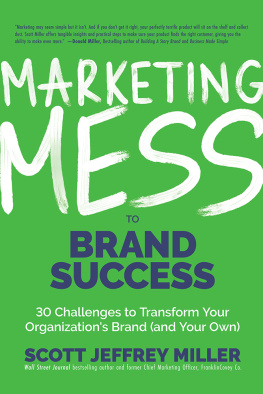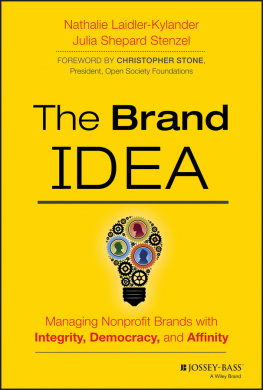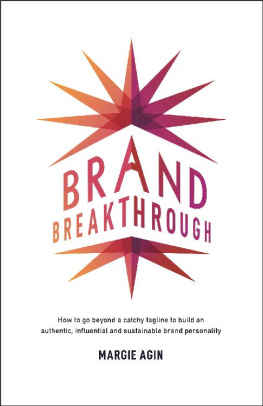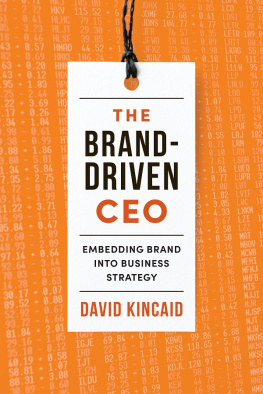
BUILDING YOUR BRAND
BUILDING YOUR BRAND
A Practical Guide for Nonprofit Organizations
MICHELE LEVY

NEW YORK
A Practical Guide for Nonprofit Organizations
2014 MICHELE LEVY.
All rights reserved. No portion of this book may be reproduced, stored in a retrieval system, or transmitted in any form or by any meanselectronic, mechanical, photocopy, recording, scanning, or other,except for brief quotations in critical reviews or articles, without the prior written permission of the publisher.
Published in New York, New York, by Morgan James Publishing. Morgan James and The Entrepreneurial Publisher are trademarks of Morgan James, LLC. www.MorganJamesPublishing.com
The Morgan James Speakers Group can bring authors to your live event. For more information or to book an event visit The Morgan James Speakers Group at www.TheMorganJamesSpeakersGroup.com.

FREE eBook edition for your existing eReader with purchase 
|
For more information, instructions, restrictions, and to register your copy, go to www.bitlit.ca/readers/register or use your QR Reader to scan the barcode: | 
|
ISBN 978-1-61448-675-6 paperback
ISBN 978-1-61448-676-3 eBook
Library of Congress Control Number: 2013935424
Cover Design by:
Rachel Lopez www.r2cdesign.com
Interior Design by:
Bonnie Bushman
In an effort to support local communities, raise awareness and funds, Morgan James Publishing donates a percentage of all book sales for the life of each book to Habitat for Humanity Peninsula and Greater Williamsburg.

| Get involved today, visit
www.MorganJamesBuilds.com | 
|
TABLE OF CONTENTS
Introduction
HOW AND WHY WOULD YOU USE THIS BOOK?
This book stems from the core belief that every nonprofit organization has a brand, that a strong brand is crucial to successfully delivering on an organizations mission, and that a strong brand requires active management. Building and managing a brand effectively is not reserved for large nonprofits or corporations with big marketing budgets. In fact, one could argue that a strong, consistent brand is even more important for organizations with limited marketing funds. If you dont have a ton of money to tell your brand story, youd better be spot on when you do tell it!
Regardless of the size of your organization or the state and maturity of your brand, it is possible, and in fact necessary, to build and maintain a strong, accurate brand to have the right reputation with the people who matter most to your success, to develop a brand that supports your strategic goals, engages your various audiences, and effectively differentiates you from the competition. This practical, user-friendly guide is specifically designed to help senior leaders and board members, as well as development and marketing staff, build and maintain that reputation.
Its important to note that while the methodology and tools you will read about in this book are consistent across the various case studies Ive chosen to illustrate them, the organizations were all very different, and they embraced the branding process in a variety of ways. Some outsourced the entire brand development process, relying heavily on a consultant to lead them through the process. Others, often those with more limited budgets and/or more in-house marketing expertise, signed up for a hybrid model in which they took responsibility for one or more phases of the work. Regardless of the size and nature of your organization and your preferred partnership model, understanding the basics of branding, as well as some best practices, will significantly increase your chances for a productive process, and for the successful long-term management of your brand.
It is my sincere hope that nonprofit leaders will be able to use this book to educate themselves before hiring a consultant, to learn what they can do on their own, and to better we start the education process with a straightforward answer to the question: What exactly IS a brand?
WHEN SHOULD YOU UPDATE YOUR BRAND?
There are a number of symptoms that can indicate a need to update your brand. For instance:
1. Have you experienced a change in strategy? Are you contemplating one?
2. If you ask a handful of staff or volunteers to describe your organization, do you get a series of different answers?
3. Do your marketing communications materials look like they come from different organizations?
While you should always be proactive and thoughtfully manage your brand, there are occasions when your brand needs a more intensive intervention for instance, when youve had a change in strategy, when your messaging has become too muddled, or when your visual identity has lost its central theme. Your brand update can happen at a number of levels, from the simple brand housekeeping to a more complete rebrand. The level of intervention and the process should be consistent with your particular needs and goals as an organization.
Many nonprofit organizations, especially smaller ones, have neither the time and resources nor the need to completely overhaul their brand. However, their fundraising efforts would benefit significantly from more clarity of messaging. For those organizations, I typically engage in brand housekeeping, which is essentially a streamlined version of a full brand strategy engagement. One small startup nonprofit, dedicated to breaking the cycle of poverty in a large city, was blessed with inspiring and energetic leadership, generous funders, and an engaged volunteer base. All of its stakeholders were extraordinarily passionate about the organization and its mission, but each stakeholder put his or her spin on the story. The result? Potential stakeholders outside the inner circle were confused as to the mission, accomplishments, and long-term goals of the organization. We worked with the senior leadership team and key inner-circle supporters to tighten up the messaging and gain consensus on a final message architecture. That brief exercise set the stage for a high profile rollout and aggressive visibility campaign, both of which would have been virtually impossible using the originally muddled messaging.
Chapter 1
FIRST THINGS FIRST
What exactly IS a brand?
I n my consulting practice and my prior life in advertising, I have found two common reactions from nonprofit leaders and board members to the concept of building a brand:
We dont need a brand, we have a mission. Brands are for corporations and other big for-profit entities.
Our brand is our logo, right?
Thankfully for the nonprofit sector, those attitudes are slowly receding. In a world where more and more nonprofits are competing for diminishing resources and where professionals transition more fluidly between the corporate and nonprofit sectors, the importance of branding and marketing is better understood (but if youre dealing with someone who STILL does not understand check out the end of this chapter for some help in making the point).
Next page
